Onykia robusta (Verrill, 1876)Common name(s): Robust clubhook squid |
|
| Synonyms: Moroteuthis japonica, M. pacifica, M. robusta, M. robustus, Ommastrephes robustus, Onychoteuthis robusta, Onykia japonica | 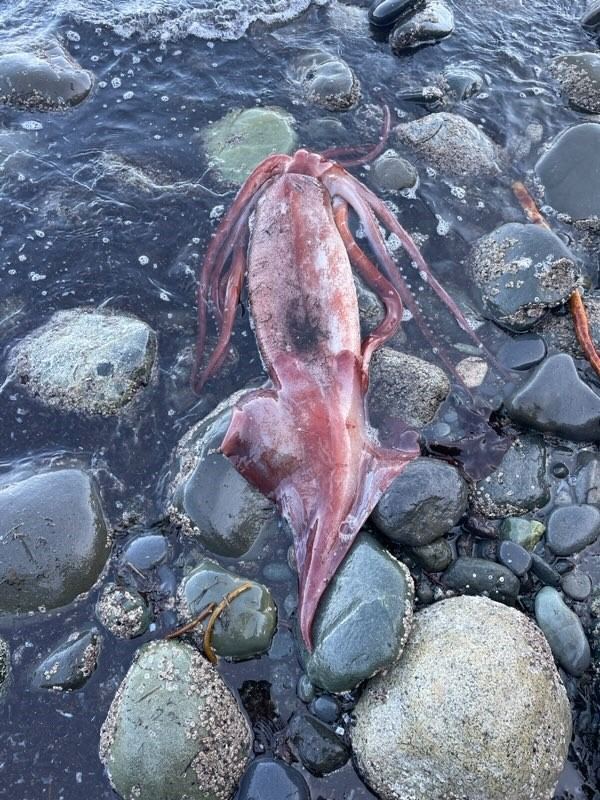 |
|
Phylum Mollusca
Subclass Coleoidea
Superorder Decaformes
Order Oegopsida
Superfamily Oegopsida
Family
Onychoteuthidae
|
|
| Onykia robusta, approximately 1.7 m long to end of arms. Washed ashore in Freshwater Bay near Port Angeles, WA on the Olympic coast of the Strait of Juan de Fuca. | |
| (Photo by: Kera Mathes, March 2023) | |
Description: Squid and Sepiolids are distinguished from Octopods by having 10 appendages (8 arms + 2 tentacles) an internal pen (gladius) for a skeleton, fins on their mantle (photo), and stalked suckers (photo) and/or hooks (photo). Squid such as this species differ from Sepiolids in having elongated mantles with tentacles that cannot be retracted into pockets, long arms that have an angular (not round) cross-section, triangular fins that are attached to the mantle along the entire fin length but still the attachment is only about half as long as the mantle (photo). Their arms are of unequal length (ventral arms longer), and their eye is covered by a transparent membrane. Genus Onykia has all of these features (Bolstad et al., 2018): a leaflike (not rhombic) gladius, a tricuspid rachidian tooth, the funnel (excurrent siphon) groove is U-shaped, the bases of the largest ventral hooks are symmetrical, and there is epidermal sculpture on the mantle (photo). They have no photophores, no secondary occipital folds, no teeth on their arm suckers, and no dactylus. Adults have no marginal suckers on the tentacle club. The rostrum is at least 20% of the gladius length. Adults of Onykia robusta have a mantle length of up to 230 cm. The surface of the mantle has fine longitudinal ridges (photo). The fins form a sagittate (arrowhead) pattern (photo) and are attached along more than half the mantle length. The clubs of their tentacles have two rows with about 15-18 pairs of hooks (photo). They have no visceral photophores nor dorsal nuchal folds. Mantle length often greater than 1.5 m.
Tsuchiya and Okutani (1991) have detailed descriptions of small Onykia robusta (identified as Moroteuthis robusta): They describe the species as a gigantic squid from the North Pacific. Mantle characteristics: In specimens less than 42.8 mm mantle length (ML) the mantle has an iridescent epidermis over many indistinct ridges. Larger specimens seem to have more pronounced ridges. Fin characteristics: In individuals smaller than 2 cm mantle length the fin outline is oval instead of triangular. By 42.8 mm ML the fins are pointed and by 60.7 ML they are rhombic. By 94 mm ML they are sagittate. The fins attach along 50-60% of the mantle length. Below 100 mm ML the fins are wider than long, but over 135 mm ML they are longer than wide. Cartilaginous ridge in the funnel groove: Seen in specimens above 60.7 mm ML. Tentacular club: Short, compact, dorsally curved, with wide aboral keel and membranes in those < 42.8 mm ML. In individuals over 60.7 mm ML the club is long, straight, and lancelike with a narrow aboralkeel. The carpus (proximal part of the club) has 10-11 suckers and 8-10 fleshy pads, and appears to be completely formed in individuals over 42.8 mm ML. The manus (central part of the club) has at least 27 hooks by 19.4 mm ML and the suckers distal to the hooks are compressed. Those larger than 42.8 mm ML have 30-32 hooks on the manus. Smaller individuals have marginal suckers, but by 60.7 mm ML they have been lost (but some remnants may still be present).
How to Distinguish from Similar Species: Adult Onykia andMoroteuthis both have large rhomboidal fins, but, unlike Moroteuthis, Onykia has an inverted Y-shaped ridge of cartilage in the funnel groove, and less rows of suckers than in other genera. The hooks on their tentacles have symmetrical grooves on them on the claw portion. The rostrum part of their gladius (internal pen skeleton) is also at least 20% of gladius length, which is more than that in Moroteuthis (10-15%).
Geographical Range: North Pacific, coastal pelagic, up to the Bering Sea.
Depth Range: Deep pelagic (captured from 60-600 m depth)
Habitat: Deep pelagic
Biology/Natural History: The eggs of this species are quite small, about 1 mm diameter. According to Bolstad et al., 2018, Onychia is closely related to Moroteuthopsis and forms a monophyletic group with it. Its closest relative, however, seems to be O. cf. robsoni which lives off New Zealand. Kurita (2018) reports that O. robusta is one of the largest deepliving squids and that it appears to have low genetic diversity such as is also found in the giant squid Architeuthis dux, which may indicate that both of those large, deep pelagic squid species may have a highly migratory pelagic paralarva.
According to Rosas-Luis et al. (2014) the diet
of Onykia
species includs euphausiids when small, and fish, squid, chaetognaths,
and squat lobsters when larger. They can be cannibalistic.
| Return to: | |||
| Main Page | Alphabetic Index | Systematic Index | Glossary |
References:
Dichotomous Keys: Carlton,
2007 (as Moroteuthis
robustus)
Kozloff,
1987, 1996 (as Moroteuthis
robusta)
General References:
Scientific Articles:
Bolstad, Kat S.R., Heather E. Braid, Jan M. Strugnell, Annie R. Lindgren, Alexandra Kubodera Lischka, Laptikhovsky Tsunemi, and Alvaro Roura Labiaga, 2018. A mitochondrial phylogeny of the family Onychoteuthidae Gray 1847 (Cephalopoda: Oegopsida). Molecular Phylogenetics and Evolution 128: pp88-97
Kurita, Y, 2018. Biological report of a giant deep-sea squid Onykia robusta collected from the Sanriku Coast, Japan: implications for low genetic diversity. Marine Biodiversity 48: pp685–688. https://doi.org/10.1007/s12526-017-0770-8
Rosas-Luis, Rigoberto, Pilar Sanchez, Julio M. Portela, and Jose Luis del Rio, 2014. Feeding habits and trophic interactions of Doryteuthis gahi, Illex argentinus and Onykia ingens in the marine ecosystem off the Patagonian Shelf. Fisheries Research 152: pp. 37-44
Tsuchiya, Kotaro, and Takashi Okutani, 1991. Growth stages of Moroteuthis robusta (Verrill, 1881) with the re-evaluation of the Genus. Bulletin of Marine Science 149:1-2 pp. 137-147
Wakabayashi, Toshie, Tsunemi Kubodera, Mitsuo sakai, Taro Ichii, and Seinen Chow, 2007. Molecular evidence for synonomy in the genera Moroteuthis and Onykia and identification of their paralarvae from Hawaiian waters. Journal of the Marine Biological Association of the United Kingdom 87:4: pp. 959-965. doi:10.1017/S0025315407056196
Web sites:
General Notes and Observations: Locations, abundances, unusual behaviors:
The individual below was found washed up just west of Port Angeles, WA and was dissected by Kera Mathes and her class. All photos courtesy of Kera Mathes.
External Anatomy:
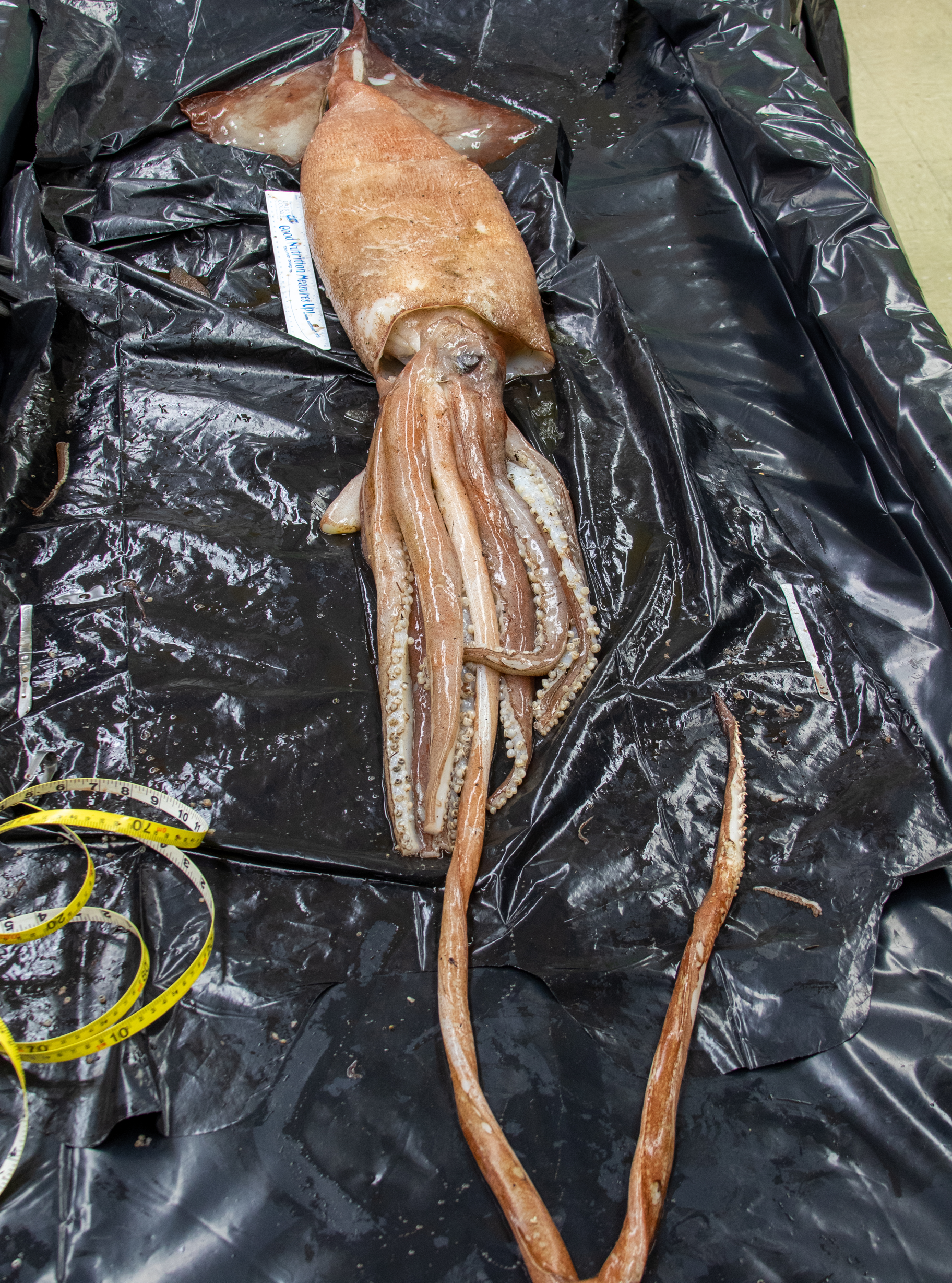
Dorsal view of the complete squid. Only one of the two long tentacles remains intact. Photo by Kera Mathes March 2023

This close-up of the external mantle shows the longitudinal ridges characteristic of this species. Photo by Kera Mathes March 2023
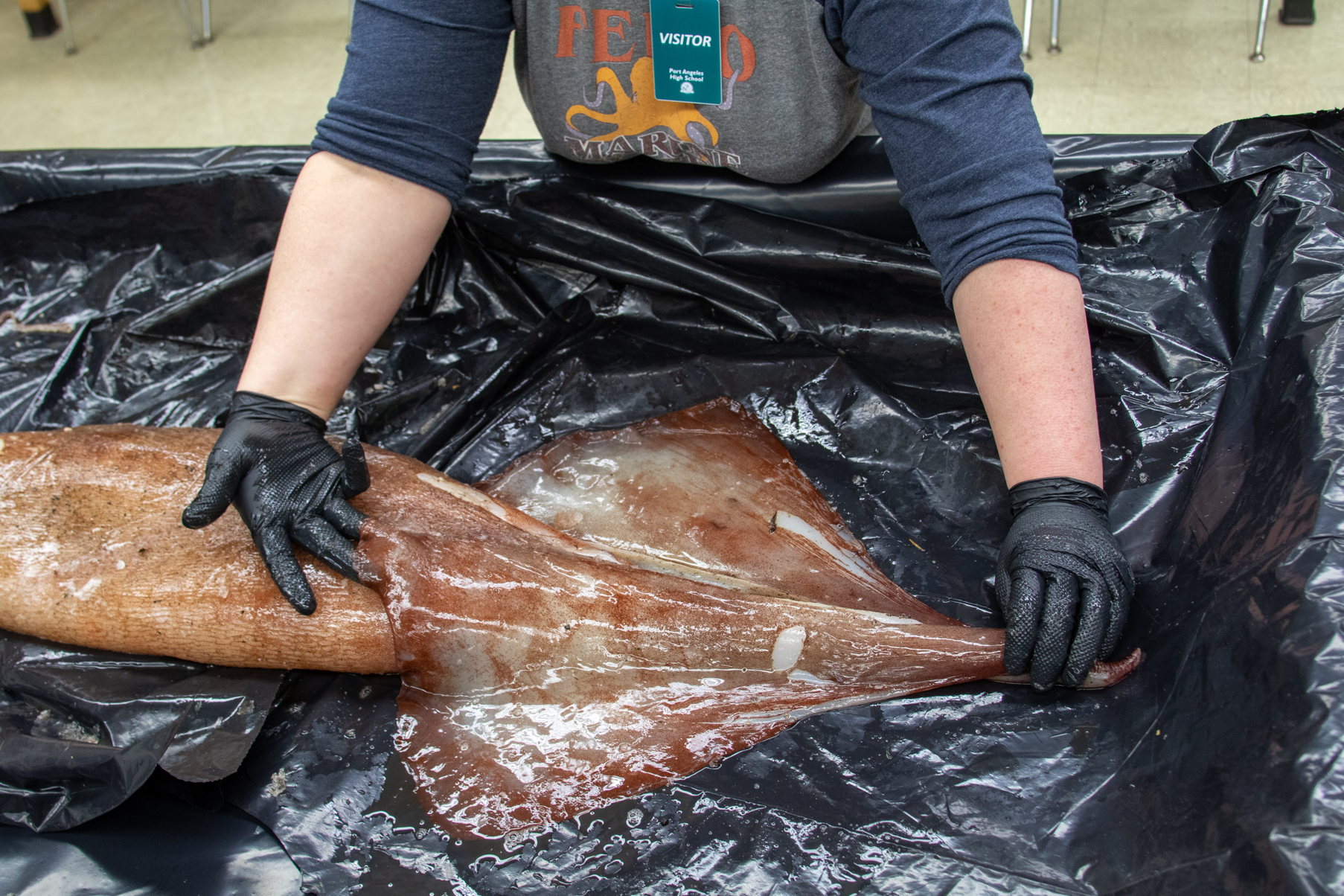
View of the fins. Photo by Kera Mathes March 2023
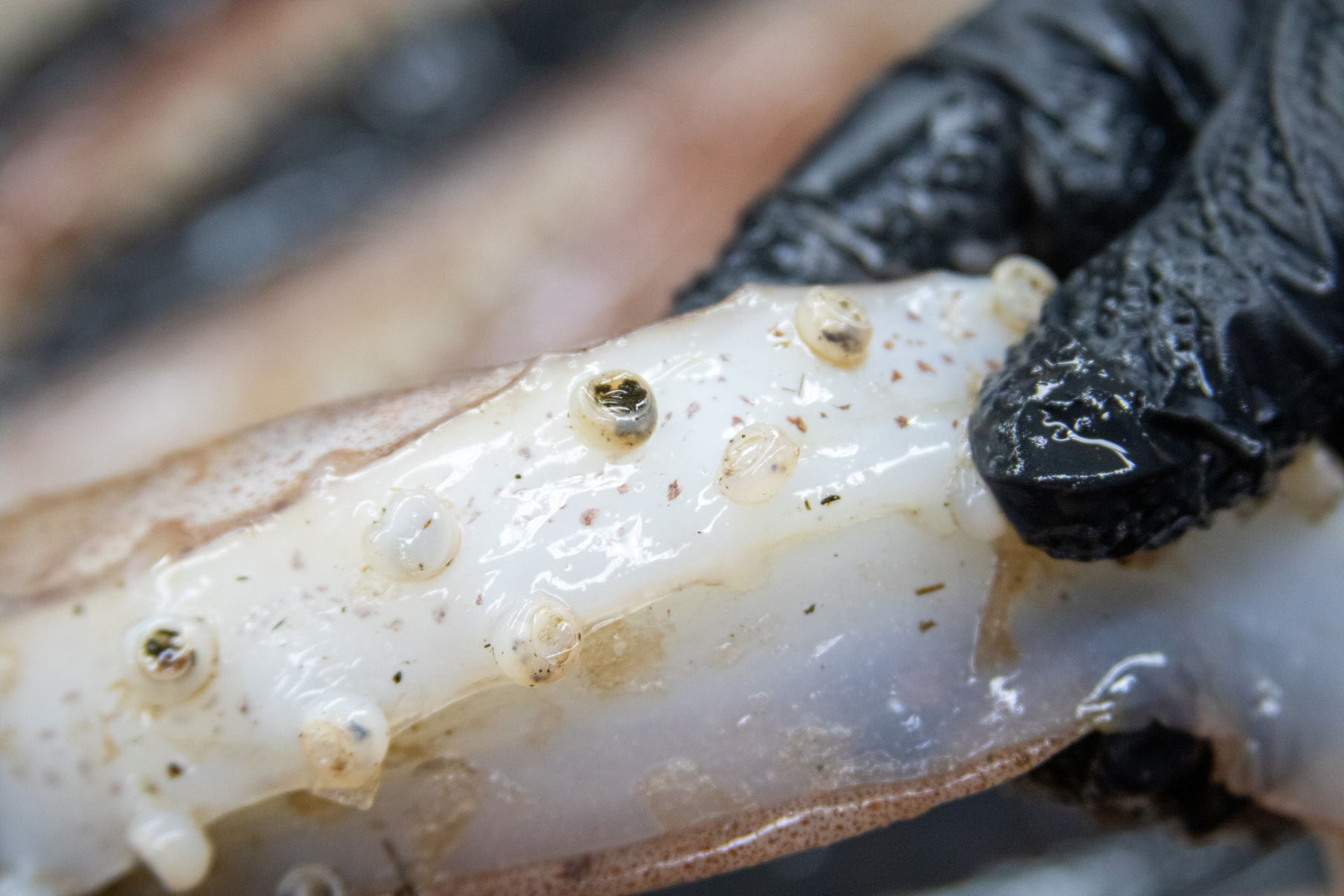
The suckers on the legs are stalked. Photo by Kera Mathes March 2023.
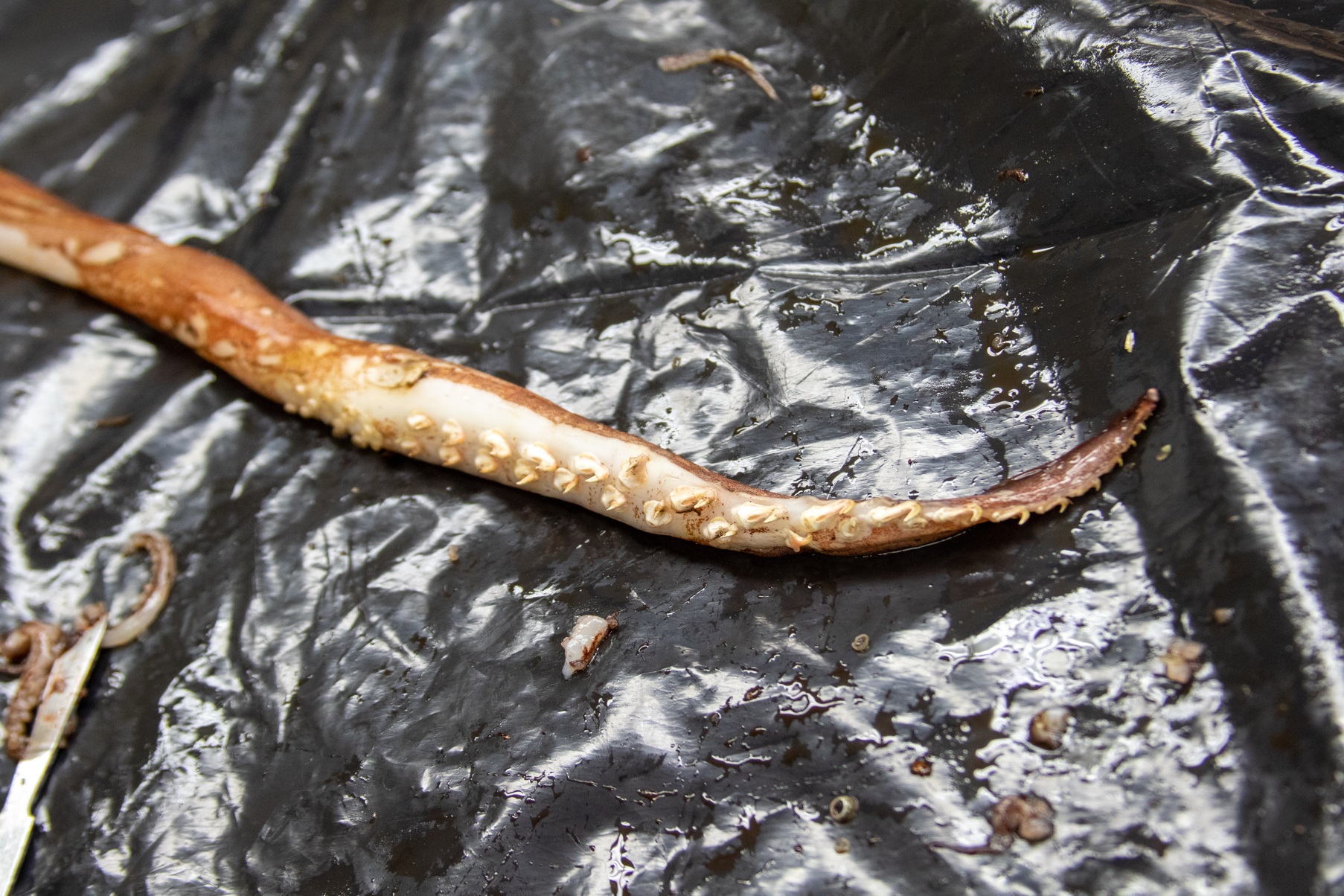
The tentacles
are
much longer than the arms
and do not have suckers for much of their length. The "clubs"
at the end of the tentacles
have the distinctive clubhooks that give this species its common name.
Photo by Kera Mathes March 2023.
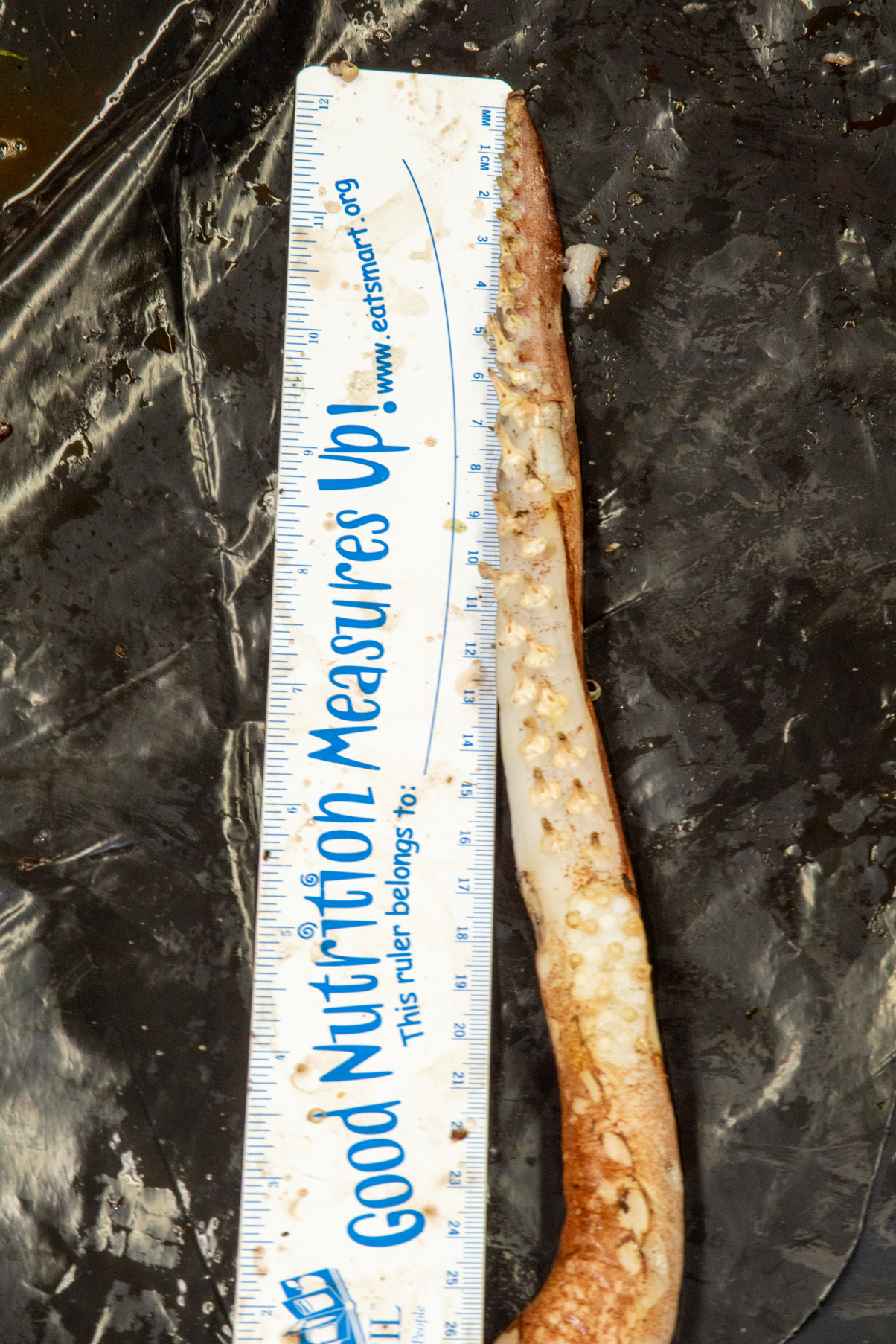
The tentacular
club on this individual is 21 cm long. Note the suckers at
the base
of the club which are likely the "fixing apparatus" referred to in
Kozloff's
key. Photo by Kera Mathes March 2023.
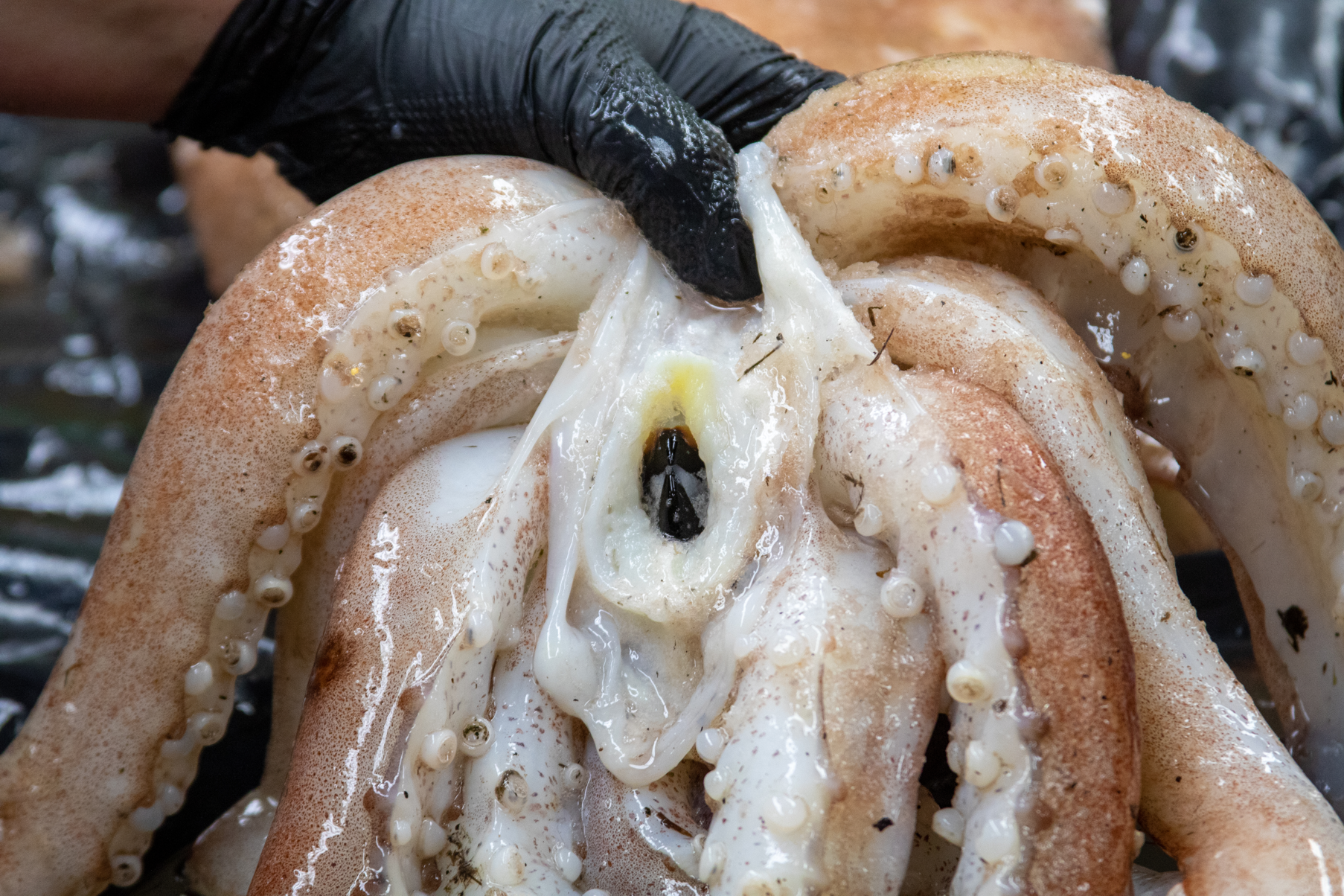
Here the mouth is held open to show the distinctive cephalopod beak
with which they tear their prey. Photo by Kera Mathes March 2023.
Internal Anatomy:
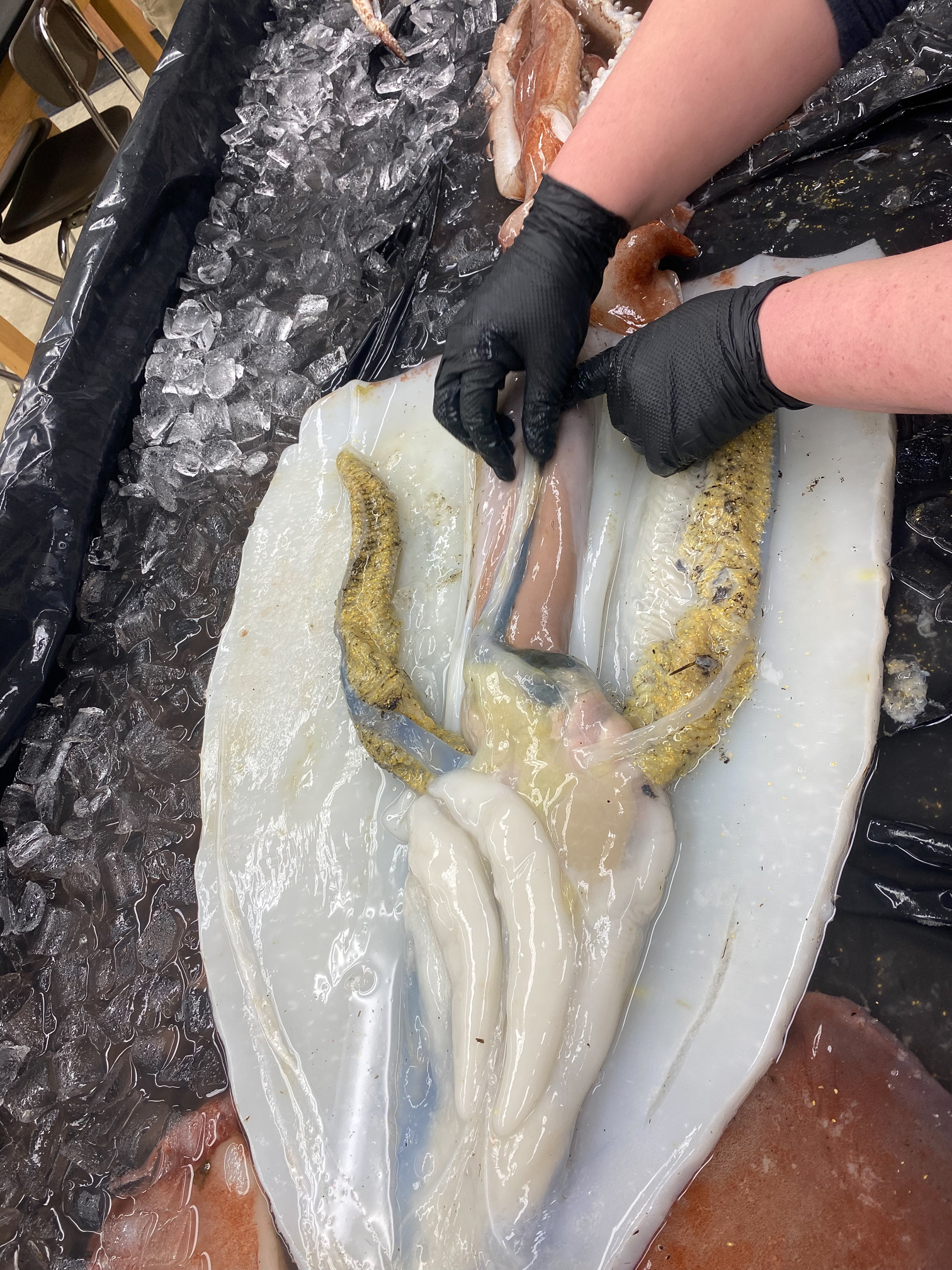
This view of the opened mantle cavity shows the large, feather-like gills. The branchial hearts are near the base of the gills and the systemic heart, kidney, and gonads are between their bases. Photo by Kera Mathes March 2023.
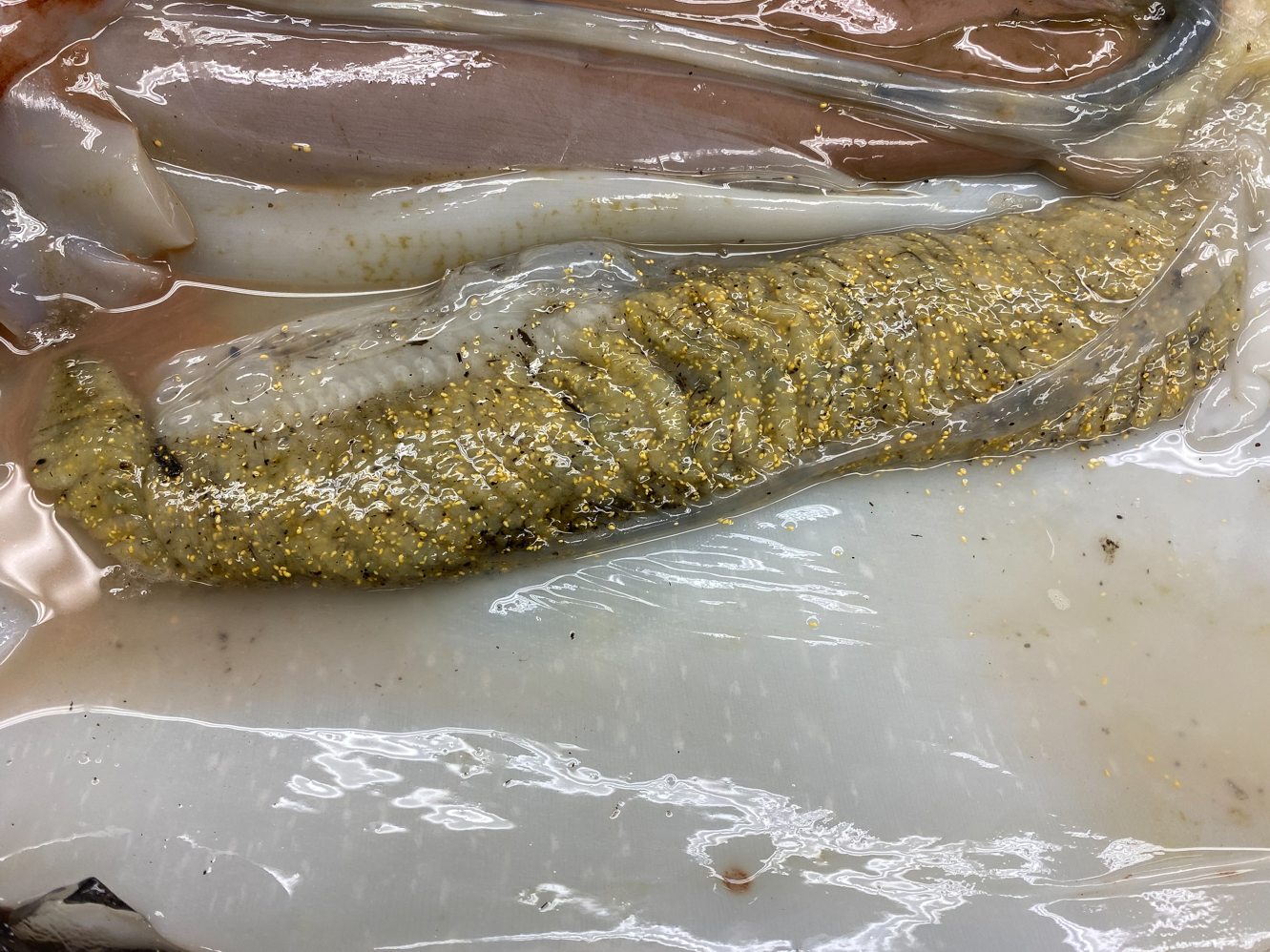
This closer view of a gill shows numerous small, golden particles
clinging
to it. These might be eggs, or could they be a life stage of a
parasite?
Dicyemids and Heterocyemids (Phylum Rhombozoa) are parasites of
cephalopod
kidneys, which are located quite close to the gills. Photo by Kera
Mathes.

This microscope view of the particles reveals no obvious body features,
nor do they have a regular shape as I would expect of eggs. Rhombozoans
have a very simple body with no body cavities or distinct organs, but
they
are quite small (Dycyemids 8-40 cells) so these may be too large to be
Rhombozoans. Photo by Kera Mathes.
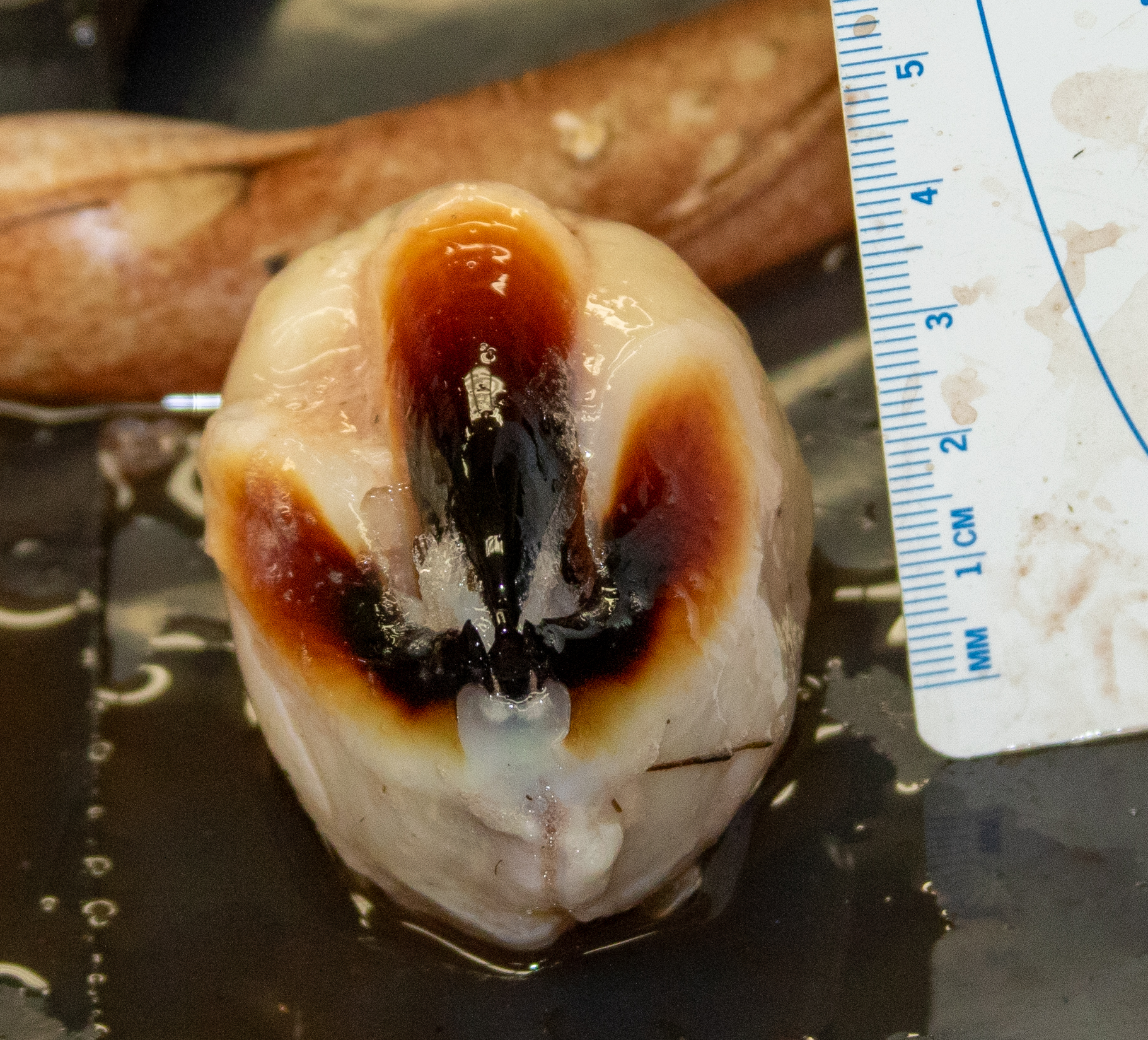
The buccal
apparatus
(beak, mouth including radula,
and associated muscles) dissected out of the squid. Photo by Kera
Mathes
March 2023.
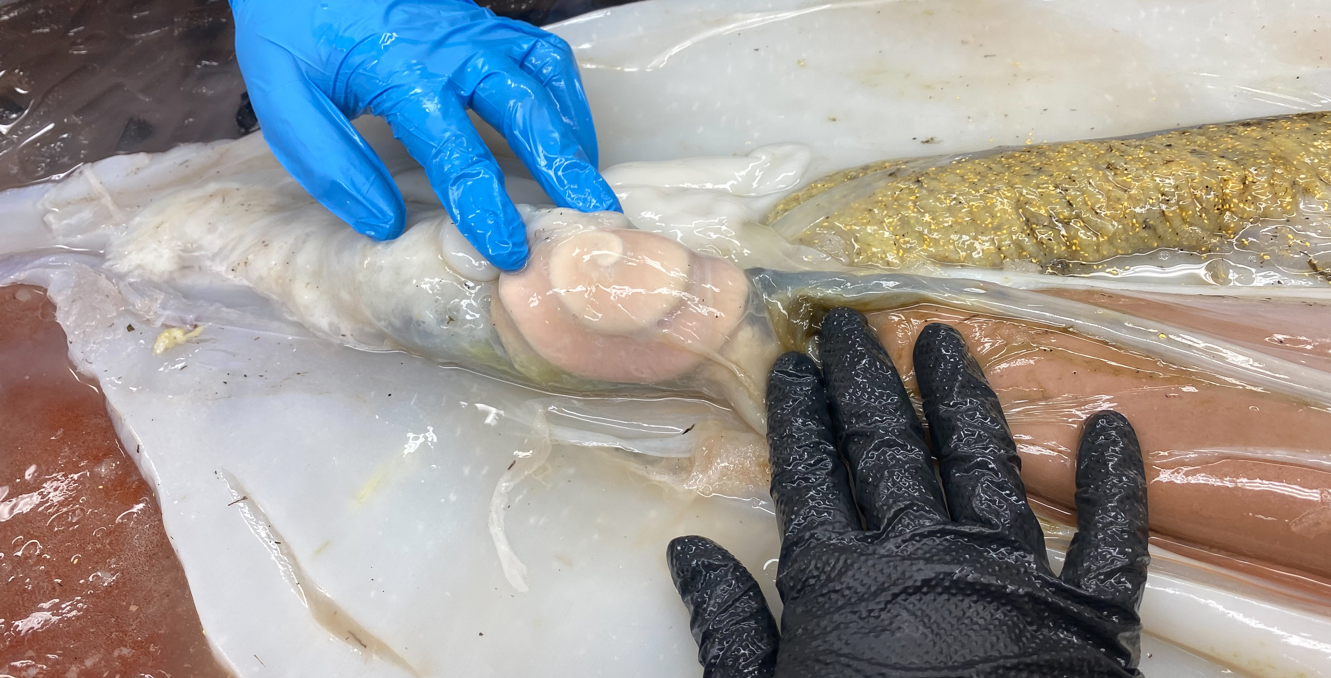
The spiral digestive gland is visible near the gills once the mantle
cavity is opened. Photo by Kera Mathes March 2023
| In July 2025 another Onykia robusta squid, about 3 feet long, washed up at Ebey's Landing on the western (most exposed) coast of Whidbey Island, WA not far from Rosario Beach Marine Laboratory. It appeared that the entire end of its mantle cavity, including its swimming fins, had been bitten or torn off. It was also missing its eyes and tentacles, and most of the arms were partly missing. Dr. Kirt Onthank dissected the squid with a crowd of student onlookers and assistants, as shown in the photos below taken by Dave Cowles. Comments for each photo are under the photo. |
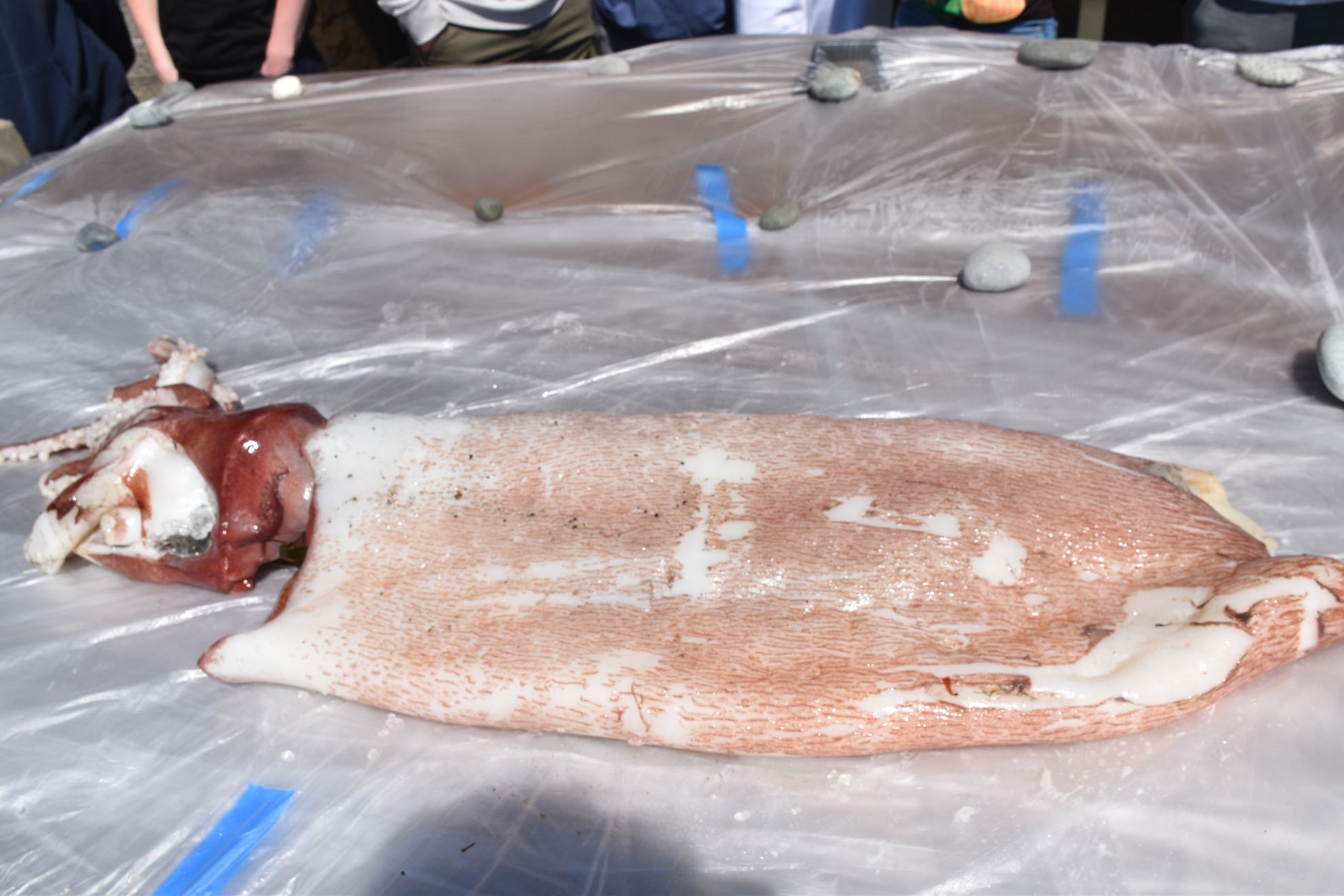 |
| Above: The entire squid, before dissection |
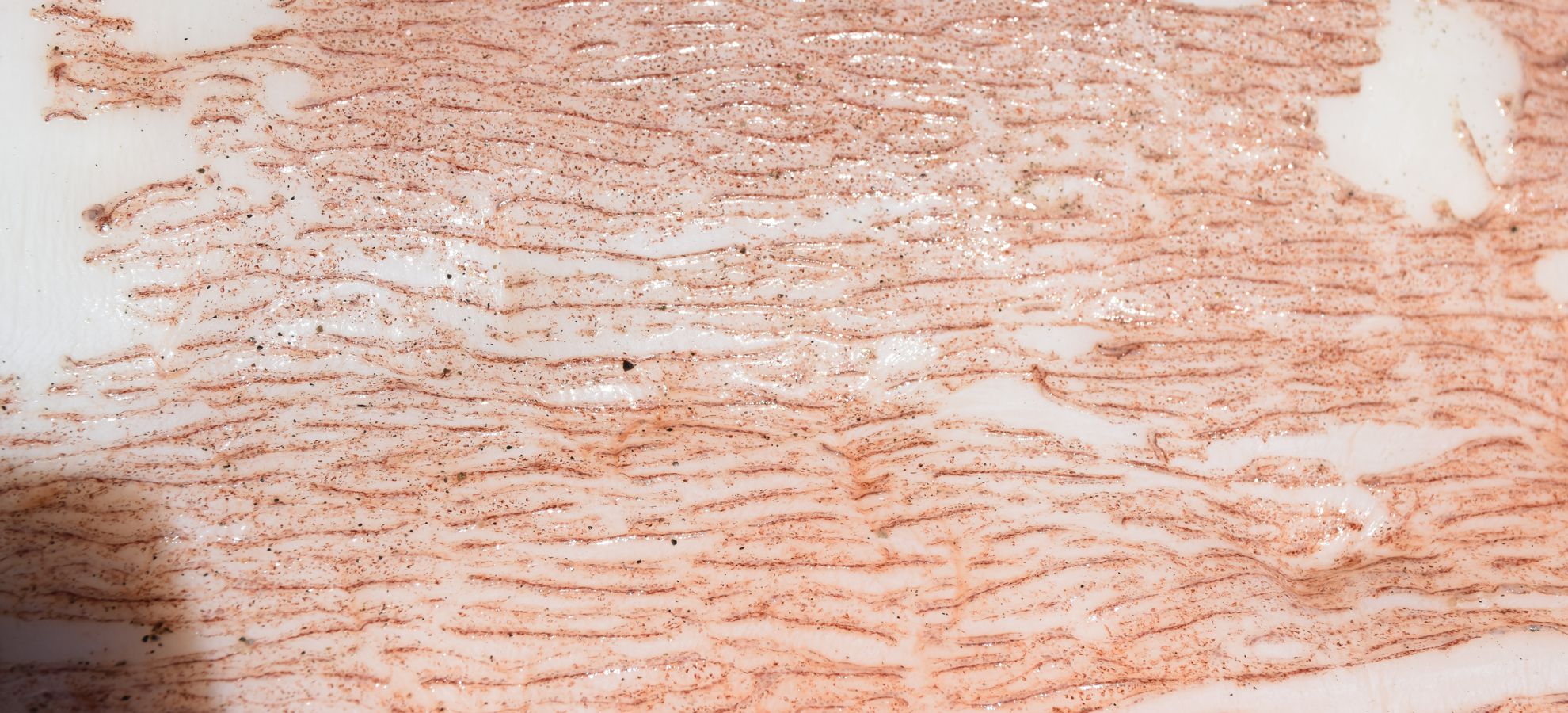 |
| Above: The skin ridges which clearly distinguish this species from Dosidicus gigas. |
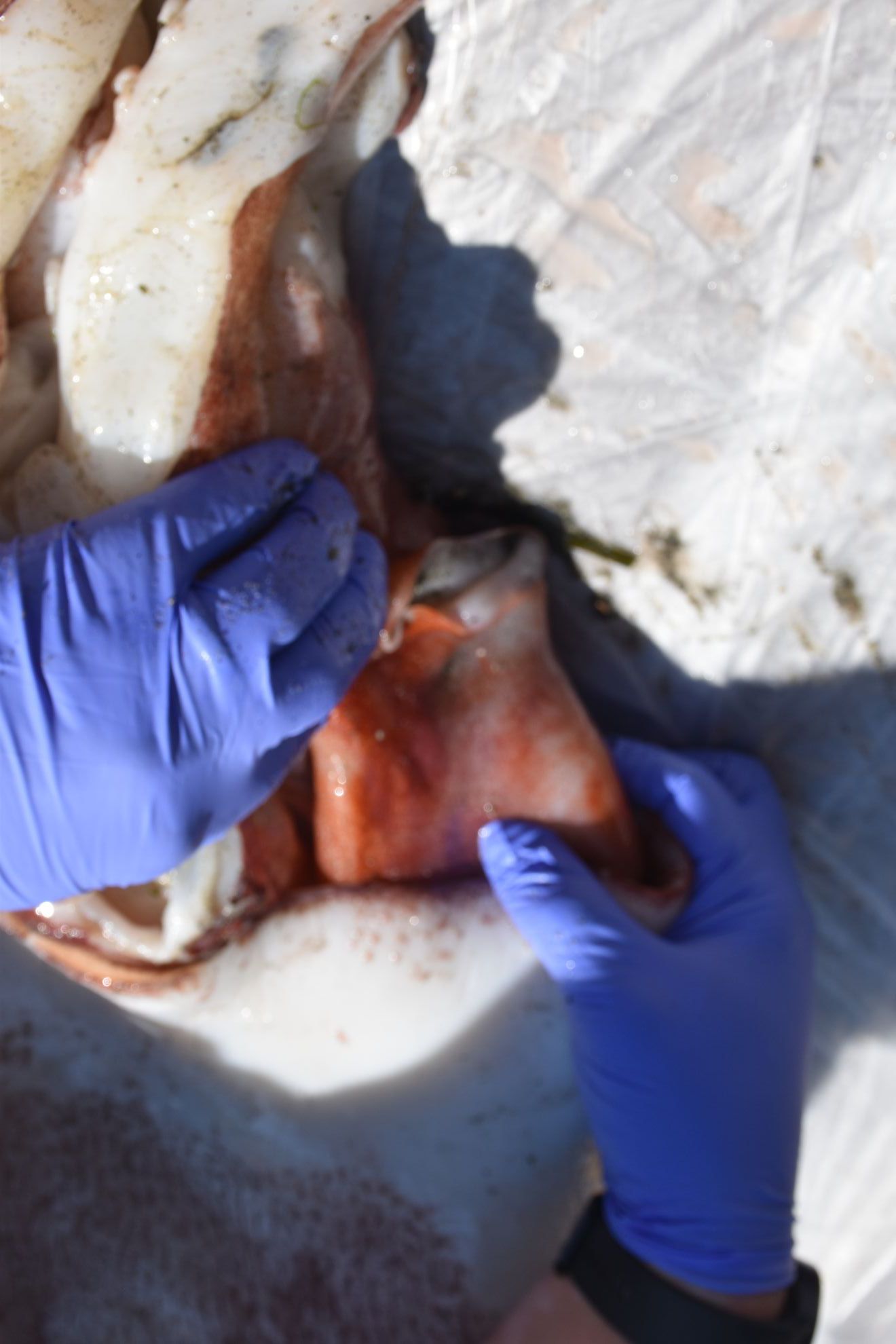 |
| Above: The animal can swim by jet propulsion using this excurrent siphon to jet water from the mantle cavity. |
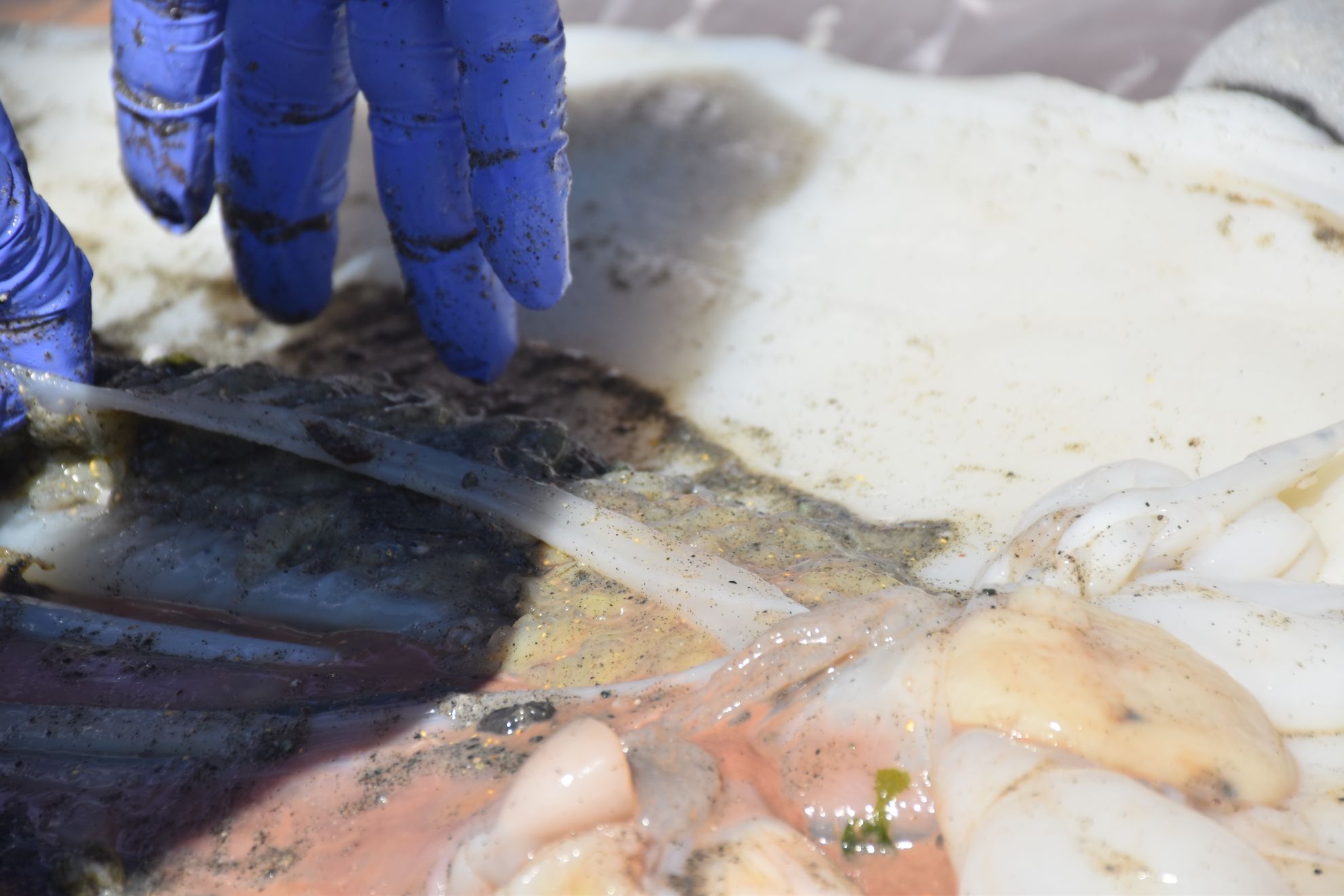 |
| Above: After opening the mantle cavity. The opening to the mantle cavity is to the left. This view is of the upper part of the mantle cavity with the two gills coming together. Near the right side of the screen are two gonads. Hidden under the gonads are the two branchial hearts, one for each gill. The systemic heart, which is partly missing, is just to the left of bottom center. |
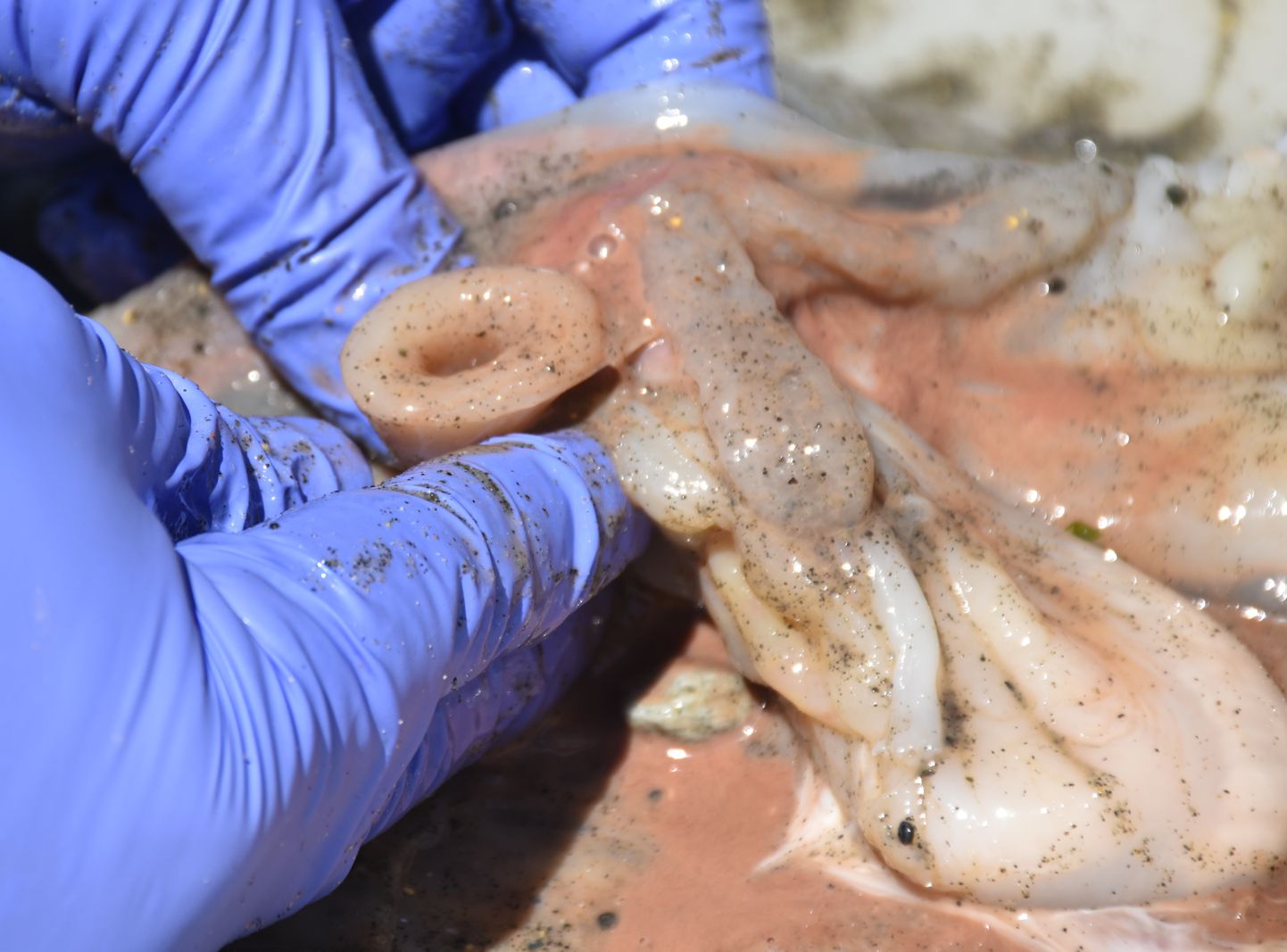 |
| Above: A view of the systemic heart, part of which is missing. The gonads and other parts of the visceral mass are to the right. |
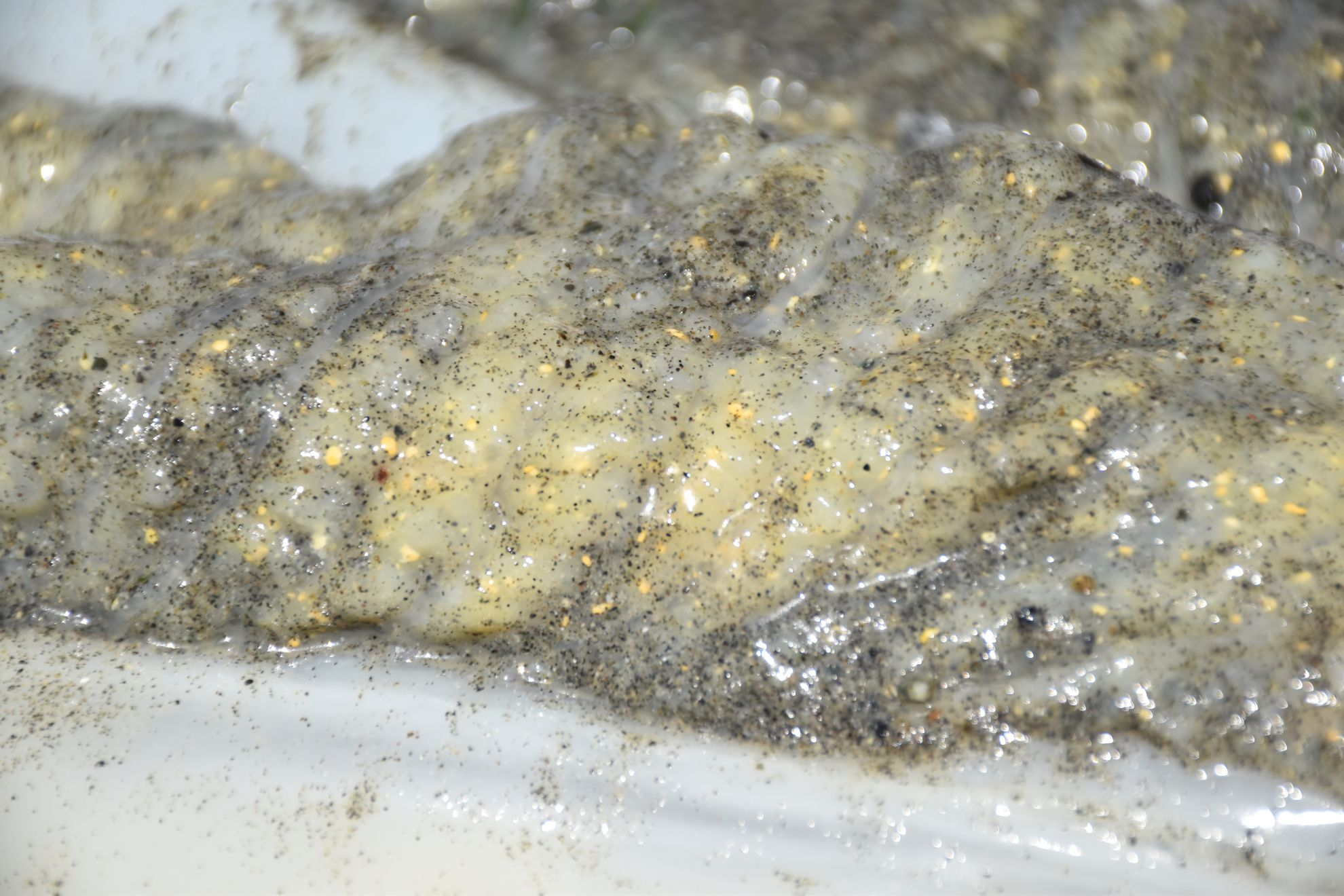 |
| Above: The gills. Besides the obvious grains of sand washed in, the gills of this individual are also strongly flecked with bright yellow spots, perhaps a parasite, as was seen in the individual above as well. |
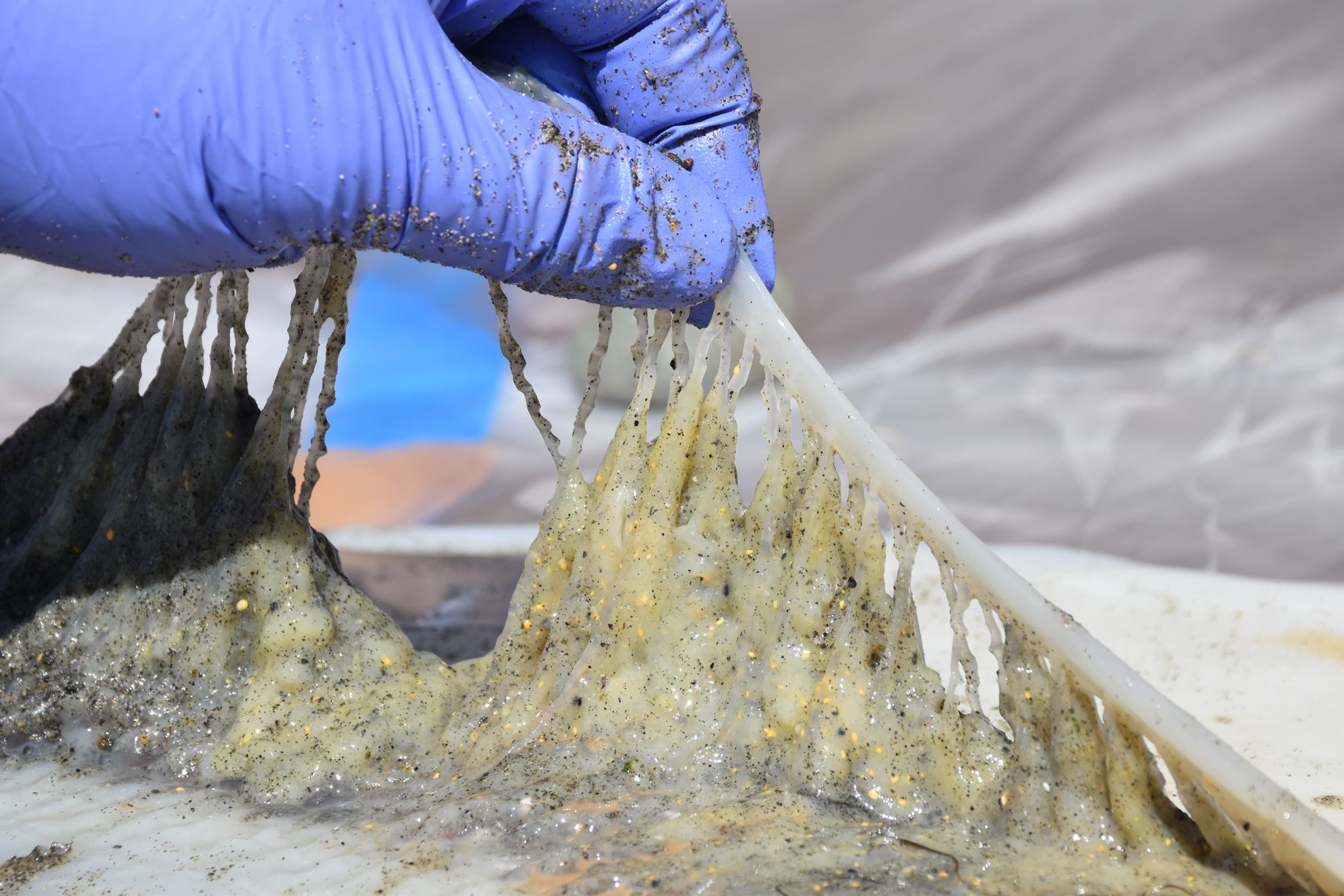 |
| Above: Lifting the gills shows the individual blood vessel paths through the gill. |
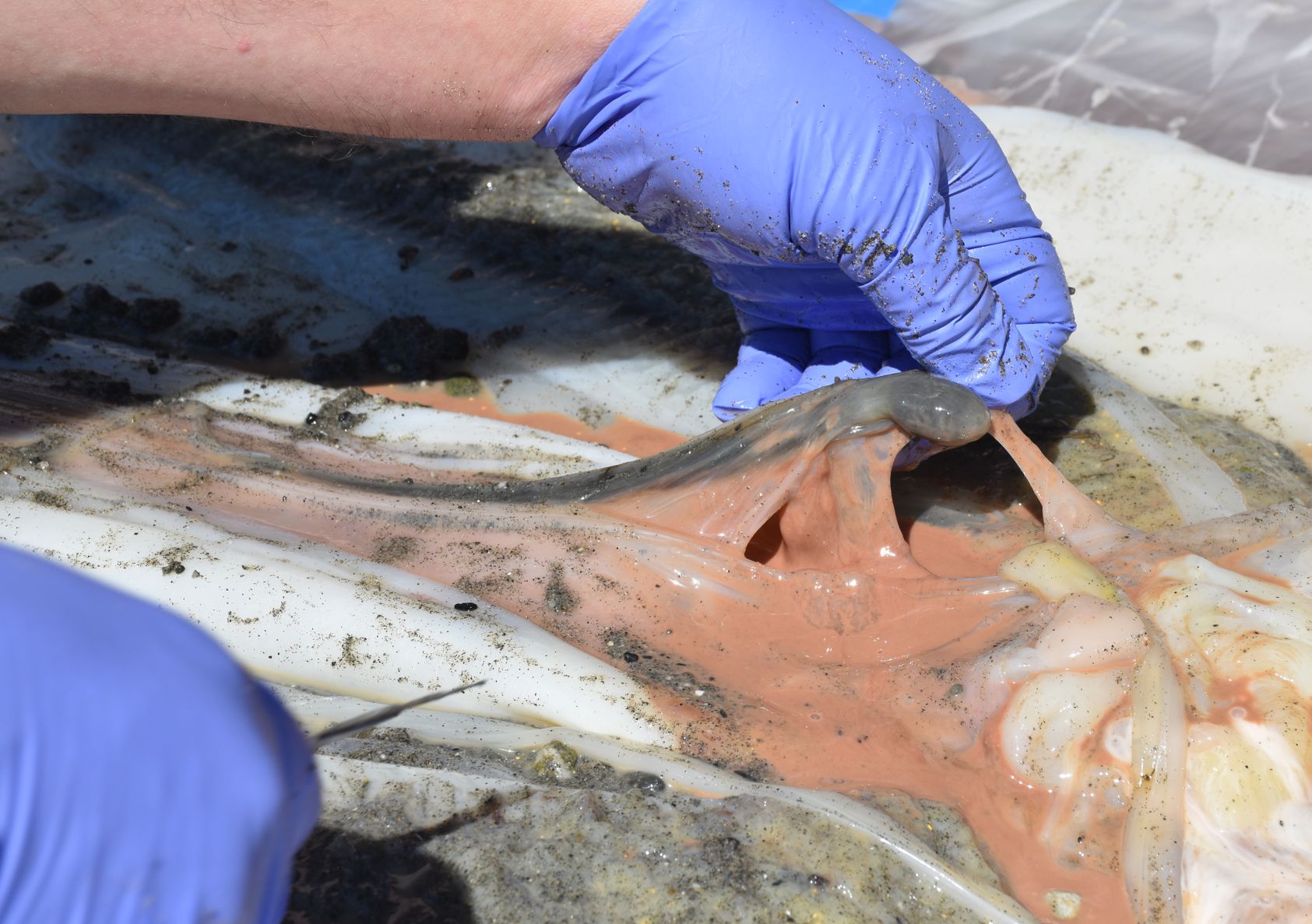 |
| Above: The ink sack lies far up the mantle cavity near the gonads, and has a long tube that extends down to near the excurrent siphon. |
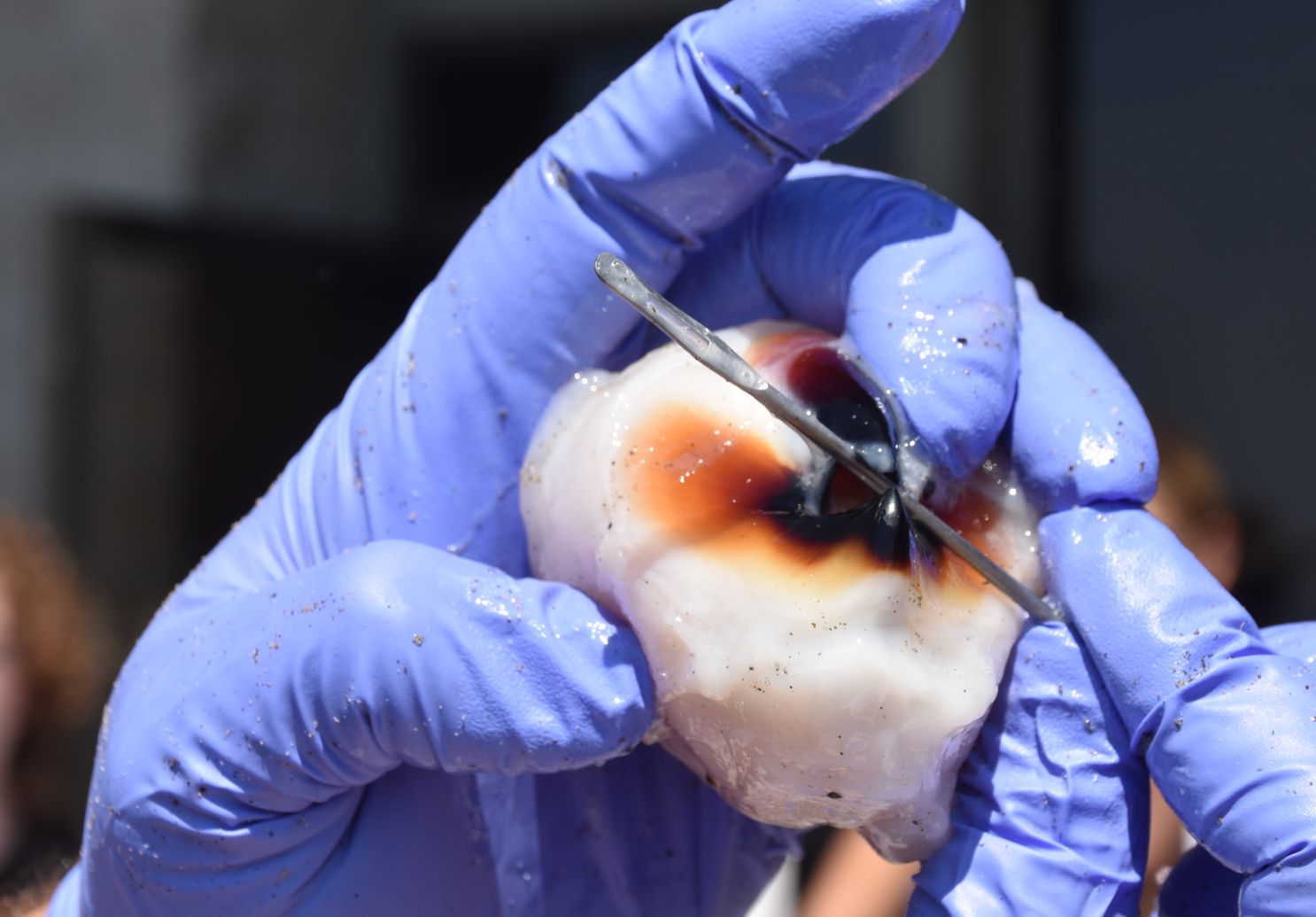 |
| Above: The buccal mass plus beak |
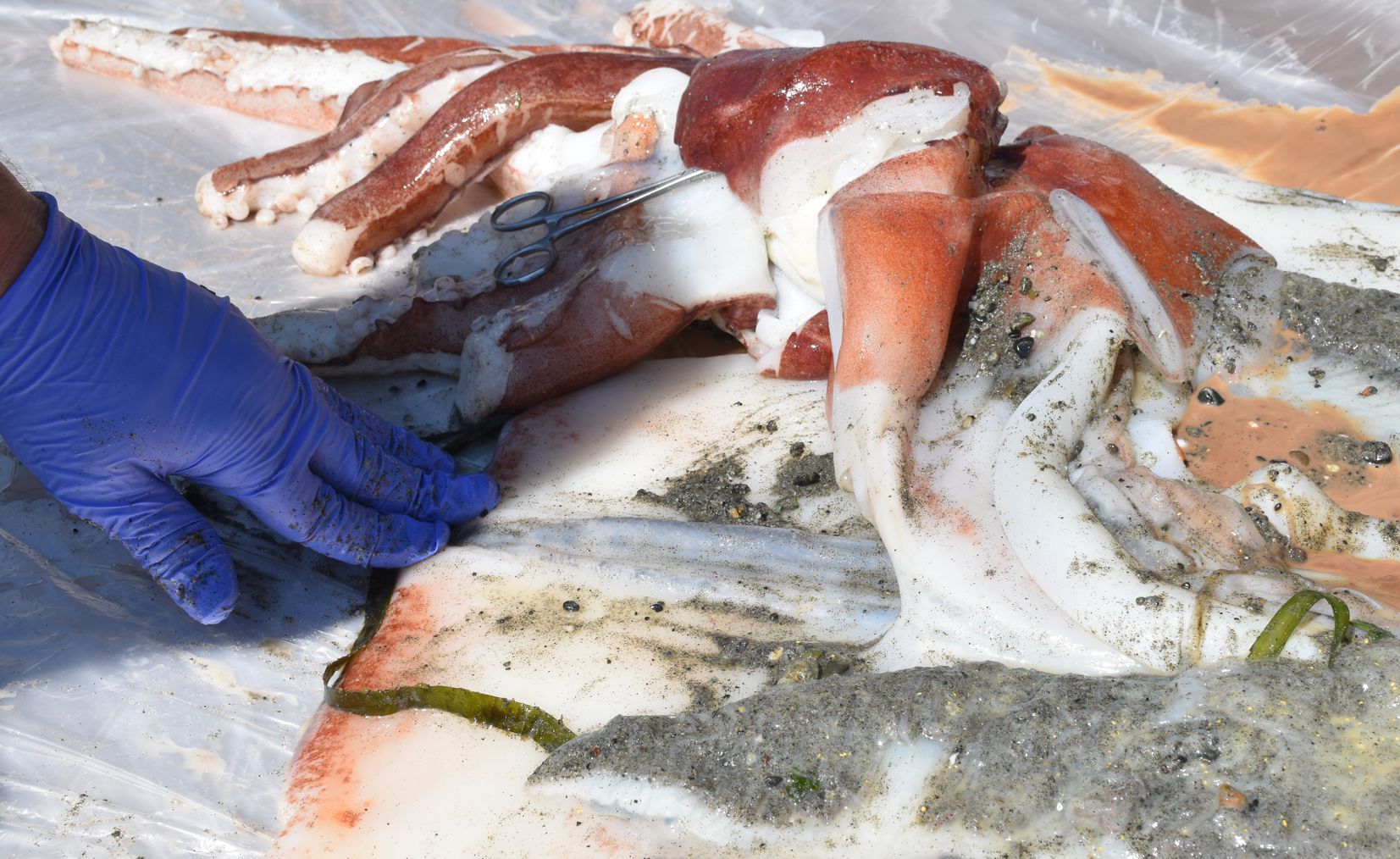 |
| Above: The gladius, or 'pen' is the internal skeleton of squid. It is a flat, clear, flexible rod which extends from the edge of the incurrent siphon (where the fingers are touching) up to the tip of the mantle cavity to the right. The upper end of the gladius in this individual was bitten or torn off. |
Authors and Editors
of Page:
Dave Cowles (2023): Created original page
CSS coding for page developed by Jonathan Cowles
Salish Sea Invertebrates web site provided courtesy of Walla
Walla University